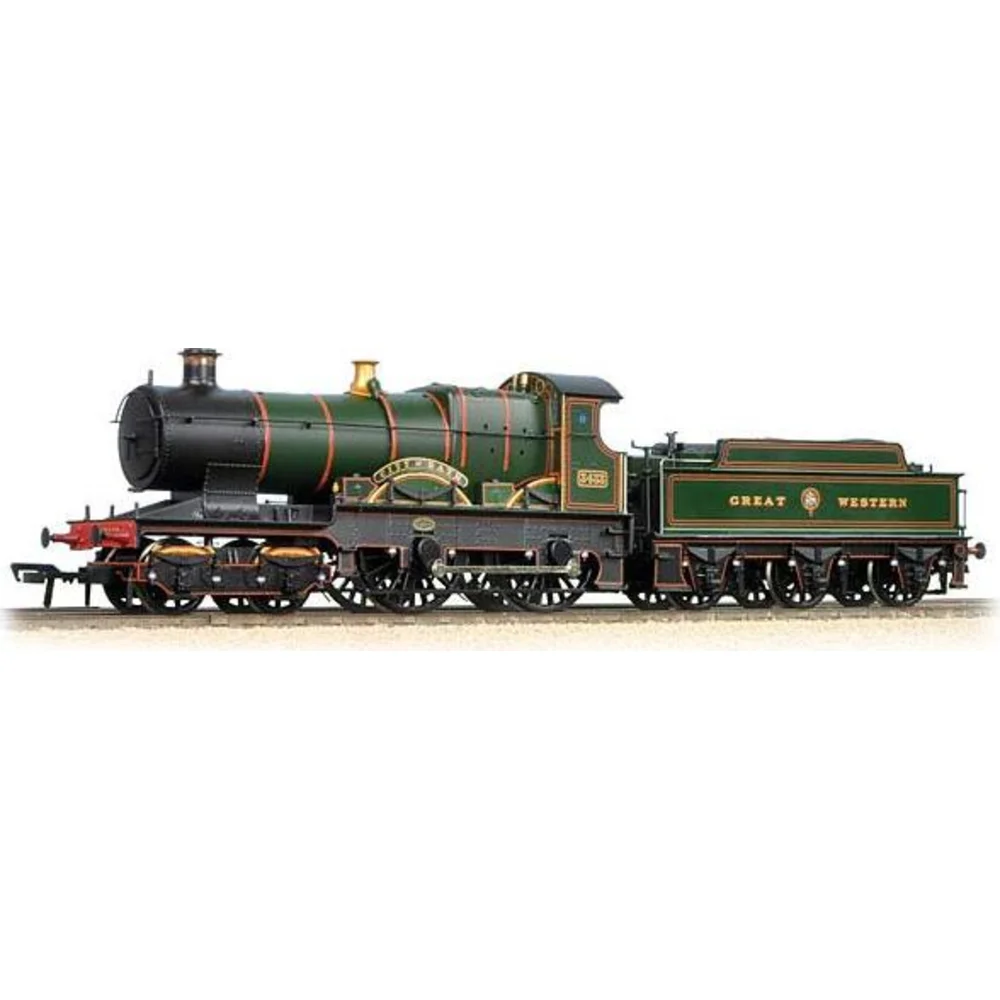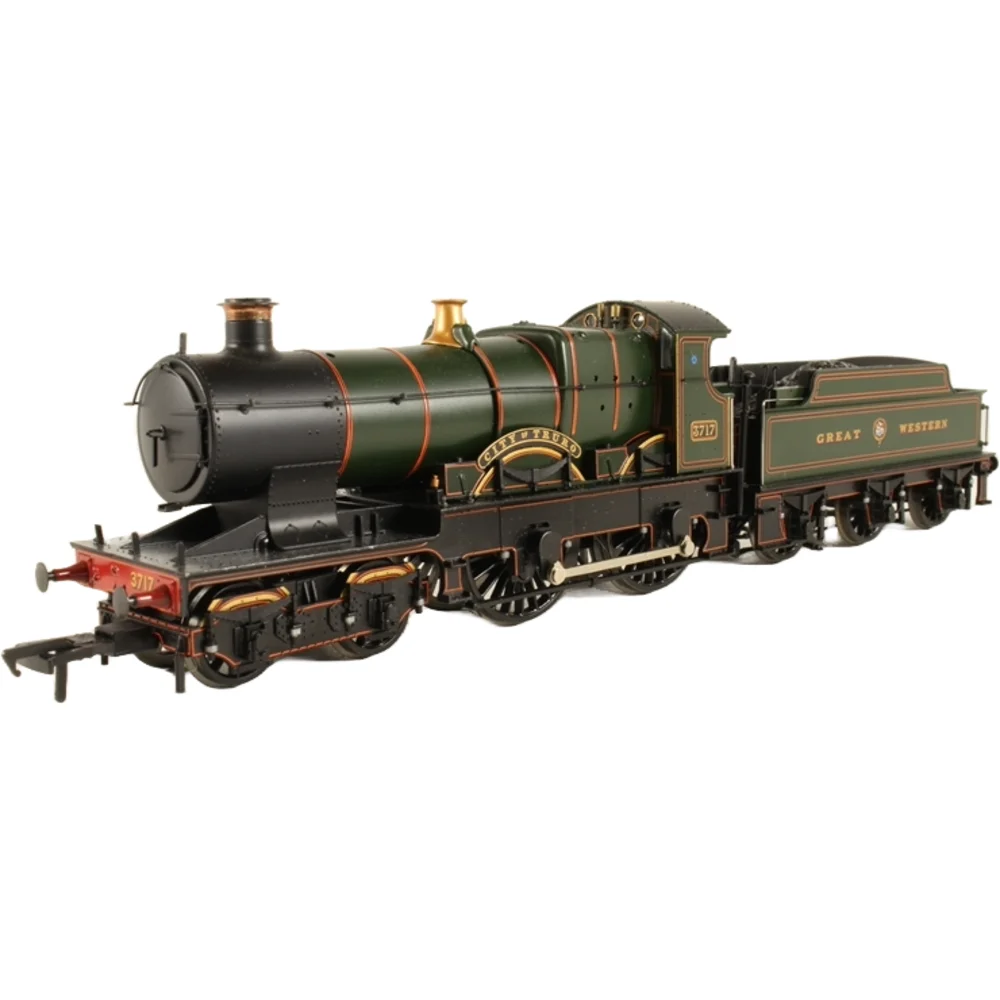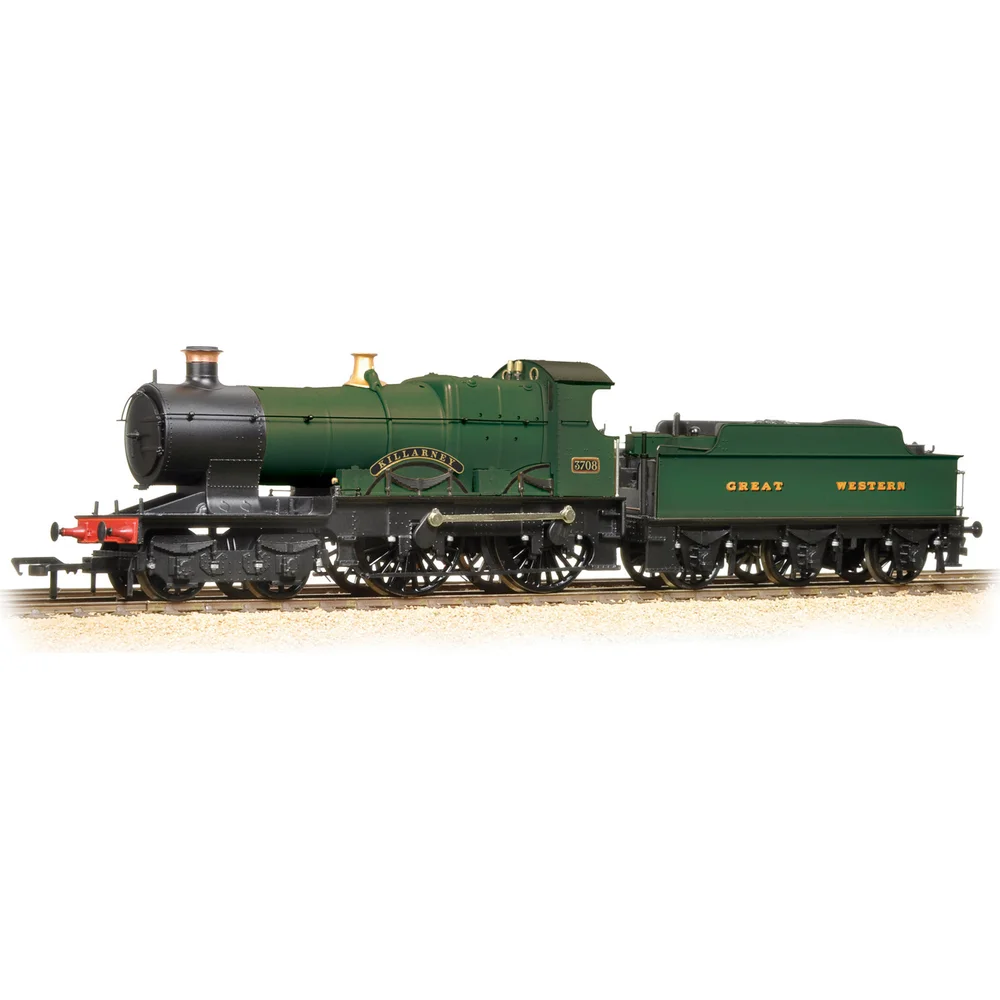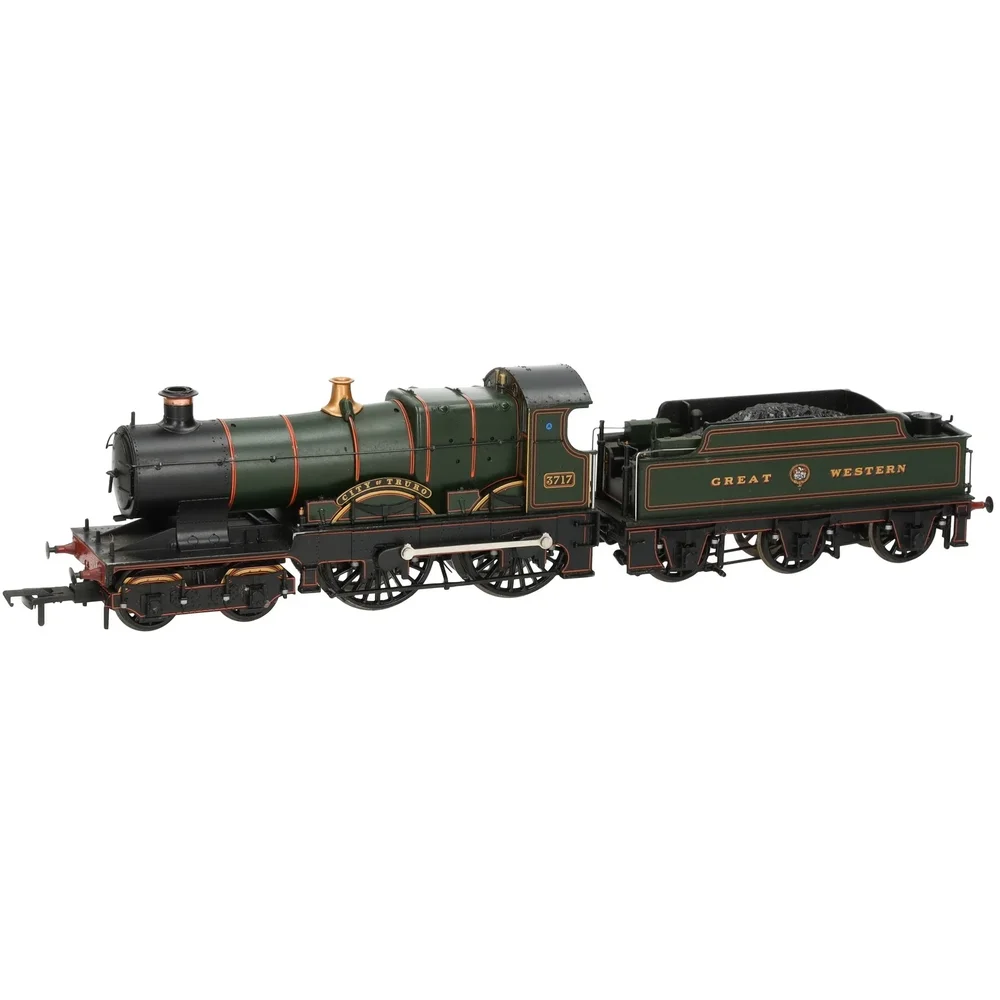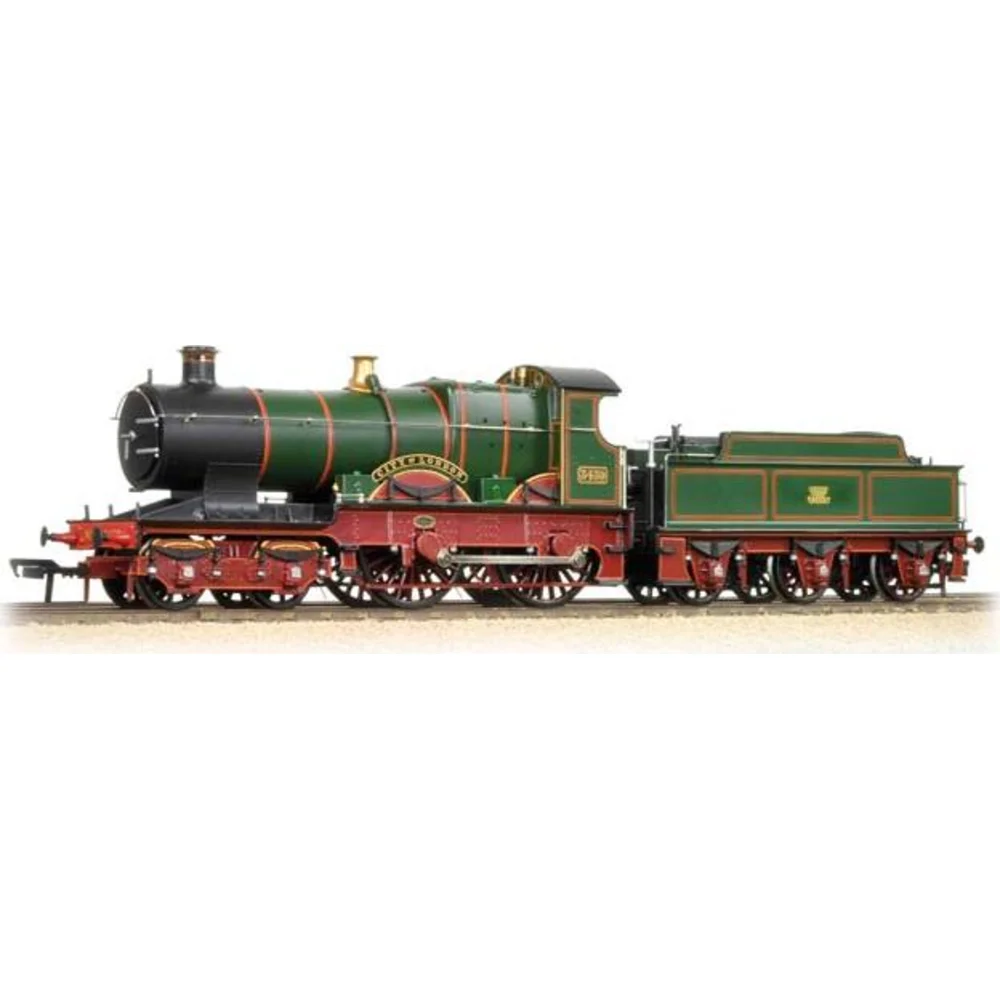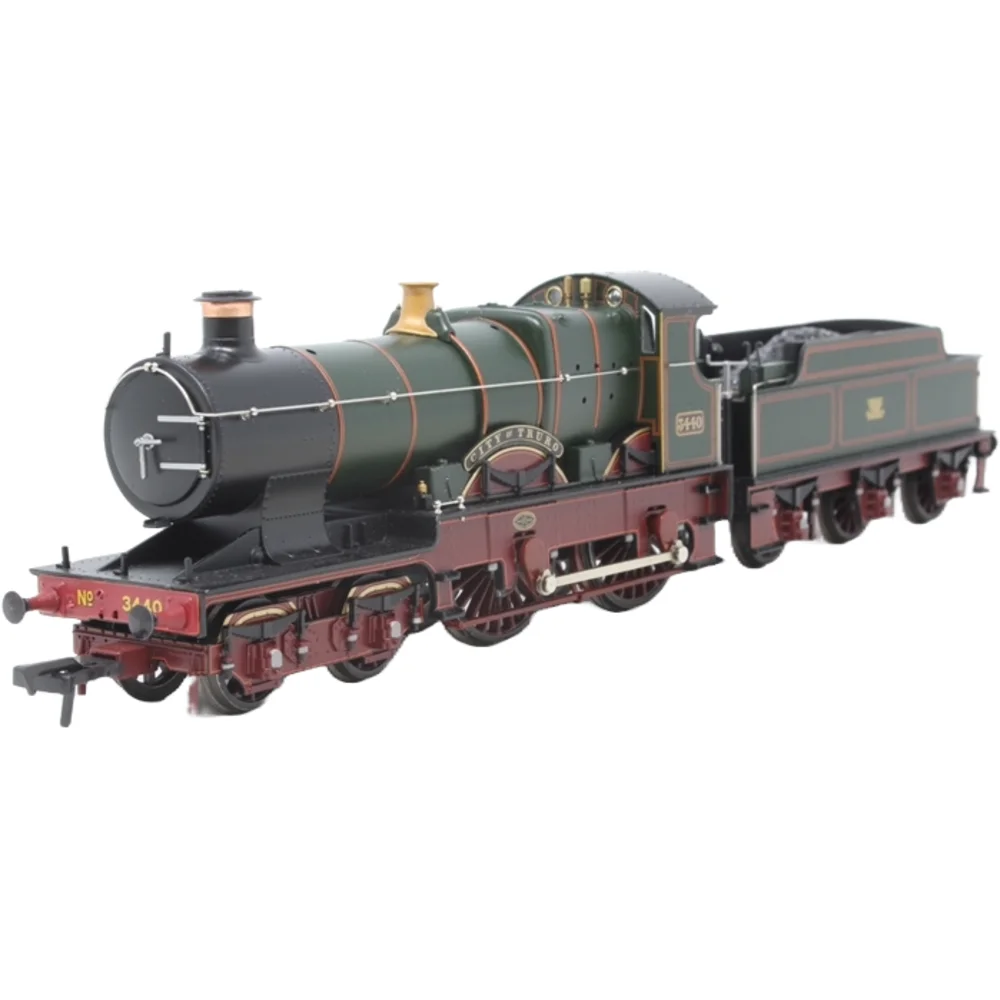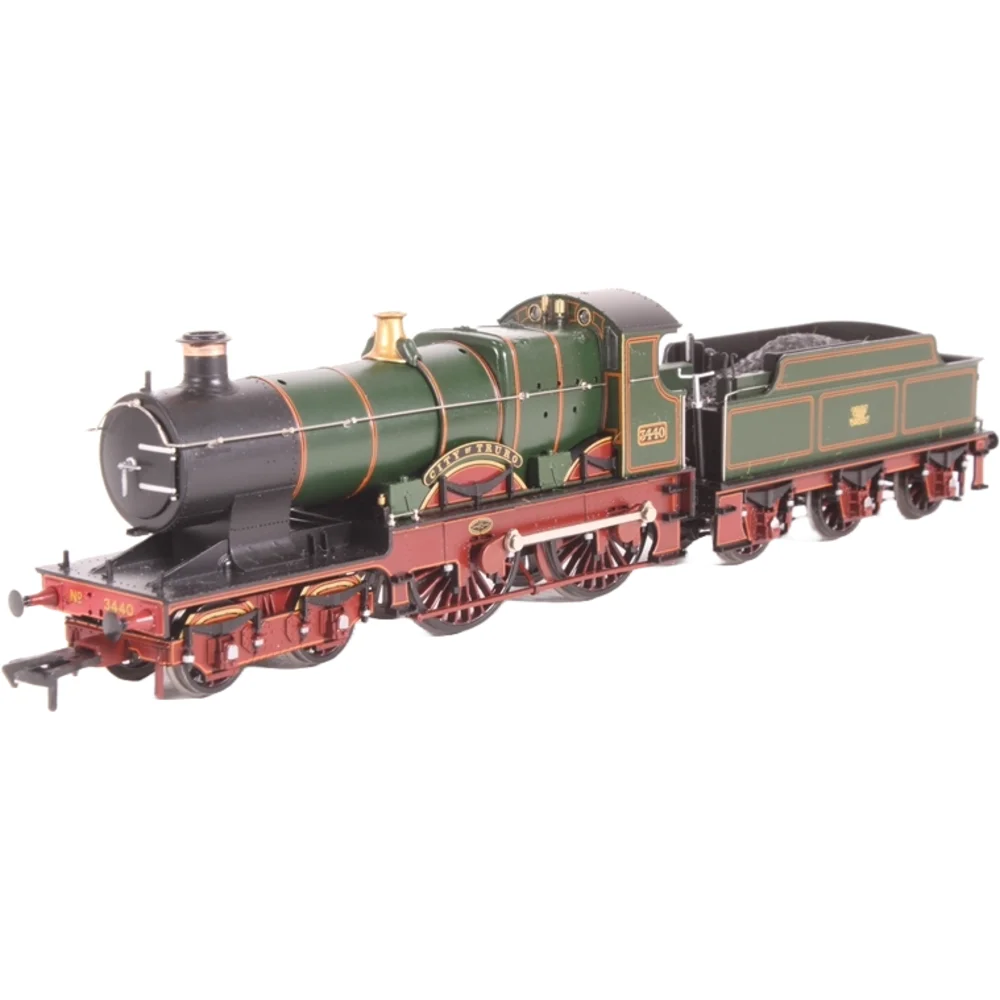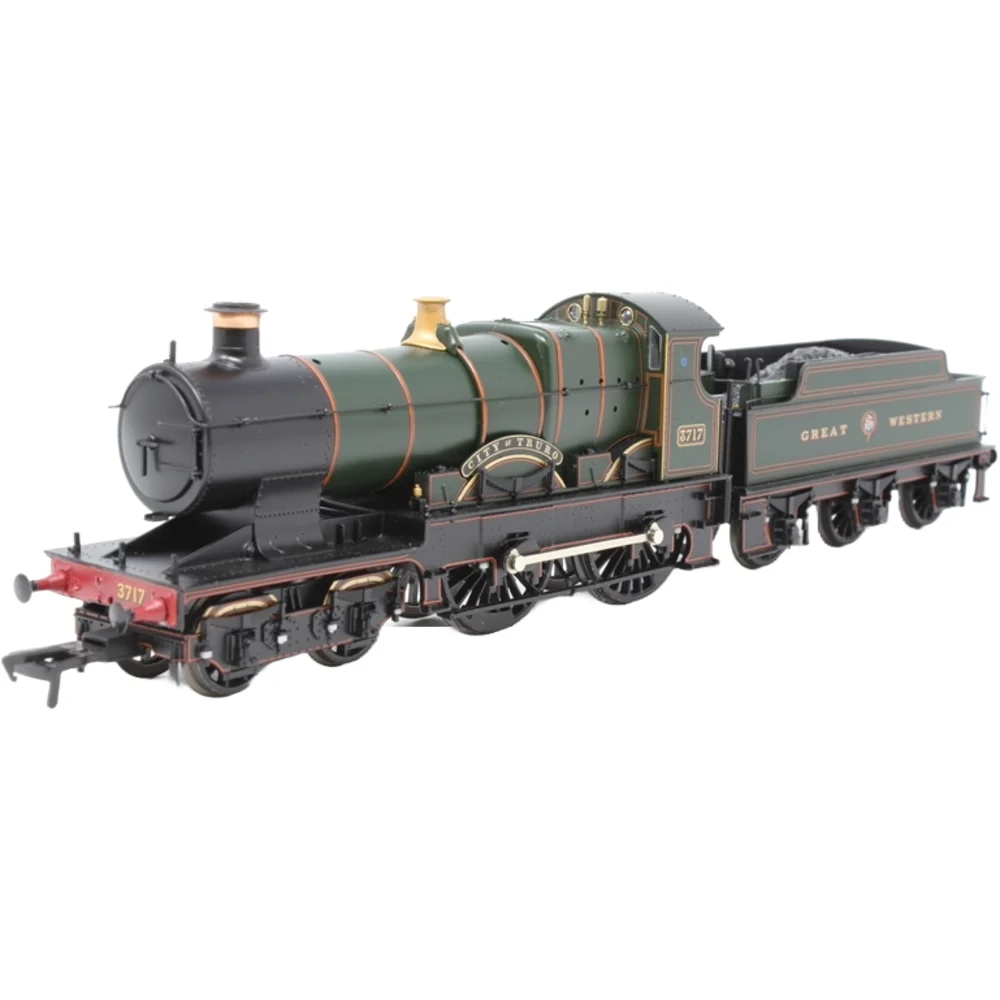GWR 3700 City Class — Churchward's Express Passenger Pioneer
Contents
- Historical Background and Context
- Design and Technical Specifications
- Service History and Operations
- Withdrawal and the Rise of Larger Classes
- Preservation and Research Significance
- Modelling Significance and Scale Replications
- Unique Modelling Tips and Layout Integration
- Technical Innovation and Engineering Legacy
- Cultural Impact and Popular Recognition
- Finally
- Frequently Asked Questions
- eBay Listings
The GWR 3700 City Class occupies a legendary place in British railway history: Churchward's pioneering express passenger design that bridged the gap between Victorian tradition and Edwardian innovation. Born from the experimental rebuilding of an Atbara Class locomotive in 1902, the City Class became the testbed for Churchward's revolutionary Standard No. 4 boiler and established design principles that would influence GWR locomotive development for decades.
Most famous for 3440 City of Truro's disputed 100mph achievement in 1904, the class combined elegant 4-4-0 proportions with cutting-edge boiler technology. For railway enthusiasts and model railway hobbyists, the City Class represents the perfect blend of Victorian elegance and Edwardian engineering prowess — locomotives that looked magnificent while pioneering the technologies that would define the golden age of steam.
This comprehensive guide explores every aspect of the GWR 3700 City Class, from Churchward's innovative design philosophy to practical modelling techniques that capture these remarkable locomotives in miniature. Whether you're researching prototype history or planning your next OO gauge centrepiece, this article provides the depth and detail that serious railway enthusiasts demand.
Quick Takeaways
- Twenty locomotives built: Ten new-builds (1903) and ten Atbara Class rebuilds (1902-1909) forming the complete City Class roster
- Prototype for Churchward standards: The class pioneered the Standard No. 4 boiler with tapered barrel and Belpaire firebox
- Speed legend: 3440 City of Truro claimed the first authenticated 100mph by a steam locomotive in 1904
- Short service life: All withdrawn between 1927-1931, replaced by more powerful Castle and King classes
- Single survivor: Only 3440 City of Truro (renumbered 3717) survives, preserved at STEAM Museum, Swindon
- Modelling appeal: Elegant 4-4-0 proportions make the class popular in OO and N scales from multiple manufacturers
- Historical significance: Represented the transition from Dean's Victorian designs to Churchward's modern standardization
Historical Background and Context
Origins: The Mauritius Experiment and Churchward's Vision
The story of the GWR 3700 City Class begins not with a new design, but with a bold experiment on an existing locomotive. In September 1902, George Jackson Churchward, recently appointed as Locomotive Superintendent, selected Atbara Class locomotive No. 3405 Mauritius for a revolutionary rebuilding program that would reshape GWR motive power philosophy.
Churchward's vision was clear: the Great Western Railway needed more powerful express passenger locomotives, but rather than simply scaling up existing designs, he wanted to establish standardized components that could be applied across multiple locomotive classes. The Mauritius experiment tested his most ambitious innovation — the Standard No. 4 boiler with its distinctive tapered barrel and Belpaire firebox.
This wasn't merely about increased power output. Churchward understood that the future of railway engineering lay in standardization, interchangeable components, and scientifically-based design principles. The tapered boiler design improved steam circulation and reduced weight while maintaining strength, while the Belpaire firebox provided greater heating surface and more efficient combustion than traditional round-topped fireboxes.
The Need for Express Passenger Power
The early 1900s brought unprecedented demands on Britain's railway network. Passenger expectations had risen dramatically — travellers demanded faster, more comfortable journeys, while increasing competition between railway companies pressured operators to improve services. The Great Western Railway's main routes to the West Country, Wales, and Birmingham required locomotives capable of maintaining high speeds with heavy express trains over challenging gradients.
Dean's existing express passenger designs, while reliable, were reaching the limits of their development potential. The Atbara Class had introduced the 4-4-0 wheel arrangement to GWR express service, but even these locomotives struggled with the heaviest trains on the most demanding routes. Churchward recognized that incremental improvements wouldn't suffice — fundamental advances in boiler technology were essential.
The success of the Mauritius trials convinced Churchward to proceed with a full class of locomotives incorporating the new boiler design. However, with typical GWR pragmatism, he chose a mixed approach: building ten completely new locomotives while rebuilding nine more Atbara Class engines to the same standard. This strategy provided the required motive power while minimizing capital expenditure.
From Prototype to Production Class
Following the successful trials of rebuilt Mauritius, construction began on the first purpose-built City Class locomotive in early 1903. No. 3433 City of Bath emerged from Swindon Works in March 1903, fitted with the refined version of Churchward's Standard No. 4 boiler. This locomotive incorporated lessons learned from the Mauritius trials, including subtle refinements to the boiler taper and firebox proportions.
The production locomotives differed from the prototype in several important details. The boiler barrel featured a slightly more pronounced taper, while the Belpaire firebox was enlarged to provide additional heating surface. These modifications reflected Churchward's methodical approach to locomotive development — each iteration incorporated improvements based on operational experience and workshop feedback.
Between 1903 and 1909, twenty City Class locomotives entered service, with the final batch being Atbara Class rebuilds rather than new construction. This extended production timeline allowed Churchward to refine details continuously, making the later locomotives subtly different from the earlier examples. For model railway enthusiasts, these variations provide fascinating prototype opportunities and explain why different manufacturers' models sometimes show apparent discrepancies.
Design and Technical Specifications
Revolutionary Boiler Design: The Standard No. 4
The heart of the City Class design was Churchward's innovative Standard No. 4 boiler, which represented a quantum leap in British boiler technology. Unlike the parallel-barrel boilers that dominated Victorian locomotive design, Churchward's boiler featured a distinctive taper from the smokebox to the firebox, creating improved steam circulation and reducing overall weight without compromising strength.
The boiler's Belpaire firebox was equally revolutionary for British practice. While common in North America and on some Continental railways, the square-topped Belpaire design was still unusual in Britain. This configuration provided significantly more heating surface than conventional round-topped fireboxes while offering superior structural strength and easier maintenance access. The combination of tapered barrel and Belpaire firebox became Churchward's signature, appearing on virtually all subsequent GWR express passenger designs.
Steam circulation within the Standard No. 4 boiler was carefully optimized through the placement of stays, tubes, and steam passages. The tapered design encouraged natural circulation currents, reducing the formation of steam pockets and ensuring more consistent steam production. Operating pressure was set at 200 psi, high for the era, reflecting Churchward's confidence in his design's structural integrity.
Chassis and Running Gear
While the boiler represented the most visible innovation, Churchward also refined the City Class chassis and running gear to complement the improved steam-raising capacity. The 4-4-0 wheel arrangement provided an ideal balance between adhesive weight and riding quality for express passenger service, with large 6' 8½" driving wheels optimized for high-speed running.
The locomotive frames followed established GWR practice with outside frames carrying the cylinders and motion. This arrangement provided excellent accessibility for maintenance while creating the characteristic "open" appearance that distinguished GWR locomotives from their more enclosed contemporaries on other railways. The outside cylinders drove the second coupled axle through conventional connecting rods and coupling rods.
Motion design followed Stephenson's link gear principles, providing precise valve timing control essential for efficient steam usage at high speeds. The valve gear was carefully proportioned to complement the Standard No. 4 boiler's steam-raising characteristics, ensuring optimal performance across the locomotive's speed range. This attention to motion design details reflected Churchward's systematic approach to locomotive engineering.
Cab and Tender Design
The City Class cab represented a transitional design between Victorian open cabs and the more enclosed structures that would become standard on later Churchward locomotives. While providing better weather protection than earlier designs, the cab retained the characteristic GWR emphasis on driver visibility, with large side windows and a relatively low roof line.
Tenders were of standard GWR pattern, carrying 3,500 gallons of water and 6 tons of coal. The tender design had been refined through years of experience to provide optimal weight distribution and adequate capacity for long express runs. The distinctive curved tender sides became a signature feature of GWR express passenger locomotives, contributing significantly to their elegant appearance.
From a modeller's perspective, these design details are crucial for accurate representation. The proportions of cab to boiler, the subtle curves of the tender sides, and the characteristic "stance" of GWR locomotives all contribute to achieving convincing miniature replicas that capture the essence of Churchward's elegant designs.
Service History and Operations
Express Passenger Duties and Route Allocations
The City Class locomotives were designed specifically for express passenger service, and their operational deployment reflected this specialization. The class was typically allocated to depots handling the most prestigious trains on the GWR network, including services to the West Country, South Wales, and the Birmingham route. Their powerful Standard No. 4 boilers and large driving wheels made them ideal for maintaining high speeds with heavy express trains over challenging gradients.
Typical duties included the prestigious Cornish Riviera Express, various West of England expresses, and fast services to Birmingham and beyond. The locomotives regularly worked long-distance assignments that showcased their stamina and reliability. Unlike freight locomotives that might rarely venture far from their home depot, the City Class engines were true nomads, working long runs that took them across much of the GWR system.
Route assignments varied throughout their service lives, but certain patterns emerged. The class was particularly associated with the challenging South Devon banks, where their combination of power and adhesion proved invaluable. The locomotives also worked extensively on the Paddington to Birmingham route, where their high-speed capabilities could be fully utilized on the relatively level sections while their power handled the gradients effectively.
The Legend of City of Truro's 100mph Run
No discussion of the City Class would be complete without addressing the legendary speed run of No. 3440 City of Truro on May 9, 1904. During a regular Ocean Mail Special working from Plymouth to London, the locomotive allegedly achieved 100 miles per hour while descending Whiteball Bank in Somerset — making it potentially the first steam locomotive to reach this milestone speed.
The run was recorded by Charles Rous-Marten, a respected railway journalist, using a stopwatch and mile posts. His calculations suggested that the locomotive reached 102.3 mph during the descent. However, the achievement remained controversial, with some experts questioning both the accuracy of the timing methods and the reliability of the mile post measurements used for the calculations.
Regardless of the debate surrounding the exact speed achieved, the run demonstrated the City Class locomotives' exceptional capabilities. The fact that a 4-4-0 locomotive could even approach such speeds with a substantial train load was a testament to Churchward's design principles and the effectiveness of the Standard No. 4 boiler. The publicity surrounding the run also helped establish the GWR's reputation for speed and technical innovation.
For railway enthusiasts, the City of Truro speed run represents more than just a technical achievement — it symbolizes the confidence and ambition of the Edwardian railway age. Model railway layouts often recreate the famous descent down Whiteball Bank, providing dramatic operating scenarios that capture the excitement of high-speed express passenger service.
Operational Reliability and Maintenance
Beyond their headline-grabbing speed capabilities, the City Class locomotives established excellent reputations for day-to-day reliability and operational efficiency. The Standard No. 4 boiler proved remarkably robust in service, with few of the teething troubles that often plagued innovative designs. This reliability was crucial for express passenger service, where delays and failures were highly visible and commercially damaging.
Maintenance requirements were generally straightforward, reflecting Churchward's emphasis on practical engineering solutions. The outside frames and cylinders provided excellent accessibility for routine servicing, while the boiler design incorporated features that simplified washout and inspection procedures. These practical considerations helped ensure high availability rates essential for intensive express passenger service.
The locomotives' operational characteristics evolved throughout their service lives as experience was gained and minor modifications were implemented. Later examples often featured improved cab arrangements, refined valve timing, and other detail improvements that reflected the continuous development philosophy that characterized Churchward's approach to locomotive engineering.
Fleet
No locomotives found.
Withdrawal and the Rise of Larger Classes
Superseded by Castle and King Classes
Despite their innovative design and excellent service record, the City Class locomotives faced inevitable obsolescence as train loads continued to increase and passenger expectations rose. By the 1920s, even the most powerful 4-4-0 designs were struggling to meet the demands of ever-heavier express trains, leading Churchward's successor, Charles Collett, to develop larger and more powerful locomotive classes.
The introduction of the Castle Class 4-6-0 locomotives in 1923 marked the beginning of the end for the City Class. These new locomotives incorporated all the lessons learned from the City Class design while providing significantly greater power and adhesion through their additional driving axle. The Castles could handle heavier trains more efficiently while maintaining the high speeds that had made the City Class famous.
The final blow came with the introduction of the King Class 4-6-0 locomotives in 1927. These massive engines represented the ultimate development of Churchward's design principles, incorporating four-cylinder layouts and even larger Standard boilers. With the Kings and Castles available for the most demanding duties, the aging City Class locomotives became redundant.
Withdrawal of the class began in 1927 and was completed by 1931, remarkably early for locomotives that were barely 25 years old. This rapid withdrawal reflected both the pace of technological advancement and the GWR's commitment to maintaining modern, efficient motive power. Most were scrapped immediately, as their specialized nature limited their potential for secondary duties.
The Survival of City of Truro
Fortunately, recognition of the class's historical significance led to the preservation of No. 3440 City of Truro (renumbered 3717 in 1912). The locomotive's fame from the 1904 speed run made it an obvious candidate for preservation, and it was retained by the GWR rather than being sold for scrap.
The preserved locomotive became a valuable ambassador for GWR engineering excellence, appearing at exhibitions and special events. During World War II, it was briefly returned to service due to locomotive shortages, demonstrating that Churchward's 40-year-old design remained fundamentally sound. After the war, it resumed its role as a preserved exhibit.
Today, City of Truro resides in the STEAM Museum in Swindon, where it serves as a testament to Churchward's innovative engineering and the transitional period it represented in British locomotive development. For model railway enthusiasts, the preserved locomotive provides an invaluable reference for accurate scale reproduction, ensuring that the legacy of this pioneering class continues in miniature form.
Preservation and Research Significance
Museum Display and Historical Value
The preservation of City of Truro at STEAM Museum, Swindon, provides railway researchers and model makers with an invaluable reference for understanding early Churchward design principles. The locomotive is displayed in its later BR-era condition, complete with modifications made during its brief wartime return to service. This presentation offers insight into how the design evolved throughout its operational life.
Museum conservation work has revealed numerous construction details that would otherwise have been lost to history. X-ray analysis of the boiler structure has confirmed the sophisticated internal arrangements that made Churchward's Standard No. 4 design so effective, while careful examination of the motion components has provided precise measurements for accurate scale reproduction.
The locomotive's documentation represents one of the most complete records of early 20th-century British locomotive construction and operation. Original works drawings, maintenance records, and operational logs provide researchers with detailed information about design evolution, performance characteristics, and service modifications. This documentation treasure trove continues to yield new insights into Churchward's engineering philosophy.
Archaeological Evidence from Scrapped Locomotives
While City of Truro is the only complete survivor, archaeological investigations at former scrapyards have occasionally uncovered components from other class members. Boiler shells, cylinder blocks, and wheel centers have been recovered from sites where the locomotives were broken up, providing additional evidence of construction variations between individual engines.
These discoveries have been particularly valuable for understanding the differences between the rebuilt Atbara Class engines and the purpose-built City Class locomotives. Subtle variations in frame construction, cylinder mounting arrangements, and boiler fittings reflect the evolutionary nature of Churchward's development program and help explain apparent inconsistencies in historical photographs.
For serious modellers seeking absolute accuracy, these archaeological findings provide crucial reference material. The ability to examine actual components, even fragmentary ones, offers insights that no amount of photographic documentation can match. Several model railway clubs have been able to incorporate these research findings into exhibition-quality reproductions.
Modelling Significance and Scale Replications
Commercial Models: OO and N Scale Options
The GWR City Class has attracted significant attention from model railway manufacturers, reflecting both its historical importance and its appealing proportions. In OO scale (4mm:1ft), the class has been represented by several manufacturers over the decades, each offering different approaches to balancing accuracy, detail, and operational reliability.
Hornby produced early representations of the class during the 1960s and 1970s, typically featuring basic detail levels and ring-field motors characteristic of that era. These models, while crude by modern standards, captured the essential proportions of Churchward's design and remain popular with collectors and operators of vintage-style layouts. The simple construction made them robust and reliable runners, qualities that ensured their longevity in many collections.
Bachmann revolutionized City Class modeling with their highly detailed OO scale releases in the 2000s and 2010s. Their models featured significantly improved accuracy compared to earlier offerings, with precisely rendered boiler tapers, authentic Belpaire firebox proportions, and finely detailed cab interiors. Bachmann's City Class locomotives typically include separate handrails, detailed valve gear, realistic weathering options, and modern five-pole motors with flywheel drives for smooth low-speed operation.
The Bachmann releases have been particularly praised for their authentic livery applications, offering both pristine and lightly weathered versions that capture the elegant appearance of these express passenger locomotives. Many Bachmann City Class models include DCC decoder sockets as standard, with sound-equipped versions featuring authentic whistle, cylinder, and motion sounds that bring the prototype's character to life during layout operation.
More recent releases from various manufacturers have benefited from modern manufacturing techniques and research advances. Contemporary OO scale City Class models typically feature separately applied handrails, detailed cab interiors, authentic livery applications, and modern motor technology. Many include 21-pin DCC decoder sockets and sound capability, allowing realistic operational scenarios that complement the class's express passenger heritage.
Models
| Builder | Catalogue # | Year | Running # | Class, Operator (Livery) "Name" | Scale | Finish | Era | DCC |
|---|---|---|---|---|---|---|---|---|
| Bachmann | 30-325 | 2014 | 3711 | Great Western Railway 3700, Railway Operating Division (Khaki) "City of Birmingham" | OO | P | 2 | DCC21 |
| Bachmann | 31-725 | 3440 | Great Western Railway 3700, Great Western Railway (Green) "City of Truro" | OO | P | 3 | DCC21 | |
| Bachmann | 31-725A* | 3717 | Great Western Railway 3700, Great Western Railway (Green) "City of Truro" | OO | P | 3 | DCC21 | |
| Bachmann | 31-725ANRM* | 3717 | Great Western Railway 3700, Great Western Railway (Green with Garter Crest) "City of Truro" | OO | P | 3 | DCC21 | |
| Bachmann | 31-725NRM* | 3440 | Great Western Railway 3700, Great Western Railway (Green with Monogram) "City of Truro" | OO | P | 3 | DCC21 | |
| Bachmann | 31-725NRMB* | 3717 | Great Western Railway 3700, Great Western Railway (Lined Green with Crest) "City Of Truro" | OO | P | 3 | DCC21 | |
| Bachmann | 31-725NRMC* | 3717 | Great Western Railway 3700, Great Western Railway (Lined Green with Crest) "City Of Truro" | OO | P | 3 | DCC21 | |
| Bachmann | 31-726 | 2012 | 3433 | Great Western Railway 3700, Great Western Railway (Green with Garter Crest) "City of Bath" | OO | P | 2 | DCC21 |
| Bachmann | 31-727 | 2012 | 3439 | Great Western Railway 3700, Great Western Railway (Green with Monogram) "City of London" | OO | P | 2 | DCC21 |
| Bachmann | 31-728 | 2015 | 3708 | Great Western Railway 3700, Great Western Railway (Green) "Killarney" | OO | P | 3 | DCC21 |
Kit-Built and Scratch-Built Opportunities
For modellers seeking ultimate accuracy or unusual variants, the City Class offers excellent kit-building and scratch-building opportunities. Several specialist manufacturers have produced white metal and etched brass kits that allow construction of highly detailed models incorporating all the subtle variations found in the prototype locomotives.
Kit-building a City Class model provides invaluable insight into Churchward's design philosophy. The relationship between boiler, frames, and running gear becomes apparent during construction, helping modellers understand why these locomotives were so successful and influential. Many advanced modellers combine Bachmann ready-to-run chassis with detailed white metal or etched brass body kits to achieve the best of both worlds — reliable operation with maximum detail accuracy.
Scratch-building offers even greater opportunities for accuracy and personalization. Using preserved City of Truro as a reference, combined with historical photographs and technical drawings, dedicated modellers can produce exhibition-quality replicas that capture every nuance of the prototype design. Bachmann's detailed models serve as excellent references for proportions and construction techniques, even when building entirely from scratch.
Livery and Weathering Considerations
City Class locomotives appeared in several different liveries throughout their relatively short service lives, providing modellers with numerous authentic options. The original GWR green livery with elaborate gold lining represented the height of Edwardian railway elegance, while the later plain green scheme reflected wartime and post-war austerity measures.
Weathering City Class models requires a delicate touch to maintain their inherently elegant appearance while suggesting realistic service conditions. Unlike freight locomotives, express passenger engines were generally kept in relatively clean condition, with weathering concentrated around specific areas such as the smokebox, cylinder drain cocks, and tender coal space.
The key to convincing City Class weathering lies in understanding the locomotive's operational environment. Express passenger service meant high speeds, premium fuel, and regular cleaning, resulting in a different weathering pattern than would be seen on freight or mixed-traffic locomotives. Subtle applications of exhaust staining, brake dust, and operational grime create realistic effects without overwhelming the model's inherent elegance.
Unique Modelling Tips and Layout Integration
Authentic Operating Scenarios
Creating convincing operational scenarios for City Class models requires understanding the type of services these locomotives typically worked. Unlike freight engines that might spend hours shunting or waiting in yards, the City Class were kept busy on regular express passenger diagrams that covered long distances at high average speeds.
Typical layout scenarios might include departure preparations at London Paddington, with the locomotive being coupled to a rake of modern corridor coaches for a West Country express. The consist should reflect Edwardian coaching stock — clerestory roofs, elaborate liveries, and the substantial construction that required the City Class's power to maintain schedule timings over challenging routes.
Speed is a crucial element in realistic City Class operation. These locomotives were designed for fast running, and layout operation should reflect this capability wherever track geometry permits. Long straight sections allow the model to demonstrate the high-speed characteristics that made the prototype famous, while gradients provide opportunities to showcase the class's climbing ability.
Period-Appropriate Coaching Stock and Consists
Accurate City Class operation requires careful attention to appropriate coaching stock. The locomotives typically hauled trains consisting of six to ten coaches, depending on the specific service and route requirements. Edwardian coaching stock featured distinctive clerestory roofs, elaborate external detailing, and the substantial construction that necessitated powerful motive power.
GWR coaching stock of the City Class era was renowned for its comfort and elegance, reflecting the railway's premium market positioning. First-class accommodation featured luxurious fittings and spacious compartments, while even third-class travelers enjoyed superior accommodation compared to many competing railways. Model coaches should capture this quality through accurate livery application and authentic detail representation.
Train lengths varied considerably depending on the specific service and season. Summer holiday expresses to West Country resorts might be double-headed or strengthened with additional coaches, while regular business services maintained more consistent formations. Understanding these operational patterns helps modellers create believable consists that reflect authentic GWR practice.
Layout Design Considerations
City Class locomotives were designed for mainline operation, and layout designs should reflect this heritage wherever possible. Long curves, generous radius geometry, and substantial station platforms create appropriate settings for these elegant express passenger engines. Cramped industrial settings or tight curves compromise both the visual impact and operational characteristics that made the prototype special.
Platform scenes offer excellent opportunities to showcase City Class models in appropriate contexts. Edwardian station architecture, period advertising, and authentic passenger figures help create convincing tableaux that complement the locomotive's elegant appearance. Gas lighting, ornate canopy work, and the substantial construction of GWR stations all contribute to period atmosphere.
Signal boxes and infrastructure should also reflect the standards of the City Class era. Manually operated semaphore signals, telegraph poles, and substantial brick or stone construction create appropriate period settings. The infrastructure of the early 1900s was built to impressive standards, reflecting the confidence and prosperity of the Edwardian railway age.
Detailed Weathering Techniques for Express Passenger Service
Weathering a City Class model requires a sophisticated approach that balances realism with the inherent elegance of express passenger locomotives. Unlike freight engines that accumulated heavy grime from coal dust and industrial environments, the City Class operated in relatively clean conditions with regular maintenance and washing.
Start with a light overall wash using diluted brown or sepia to remove the artificial "plastic" appearance of new models. This base coat should be barely perceptible but helps unify the various colors and creates a foundation for subsequent weathering effects. Allow this base coat to dry completely before proceeding with more specific weathering applications.
Smokebox weathering should suggest regular firing rather than heavy accumulation of soot. Use an airbrush or soft brush to apply light gray and black weathering around the smokebox door and chimney base. The weathering should fade gradually toward the boiler barrel, creating a natural transition that suggests realistic exhaust patterns from high-speed operation.
Cylinder and motion weathering requires particular attention to authenticity. Apply small amounts of glossy black paint or weathering solution to represent oil and grease around bearing surfaces, valve chests, and coupling rod joints. Use cotton swabs to create realistic oil streaks that follow gravity and air flow patterns. Remember that express passenger locomotives received regular attention, so weathering should suggest recent service rather than long-term neglect.
Technical Innovation and Engineering Legacy
Influence on Subsequent GWR Designs
The City Class locomotives served as crucial stepping stones in the evolution of GWR motive power, bridging the gap between Victorian tradition and the standardized designs that would define the railway's golden age. The lessons learned from City Class operation directly influenced the development of larger and more powerful locomotive classes, ensuring that Churchward's engineering philosophy continued to evolve and improve.
The Standard No. 4 boiler proved so successful that it was adapted and scaled for use on subsequent designs. The tapered barrel principle appeared on virtually all later Churchward and Collett express passenger locomotives, while the Belpaire firebox became a GWR trademark. This standardization philosophy reduced manufacturing costs, simplified maintenance procedures, and ensured consistent performance characteristics across the locomotive fleet.
Motion and chassis design elements from the City Class also influenced later developments. The outside frame arrangement, cylinder proportions, and valve gear layouts established templates that were refined and enlarged for the Castle and King classes. This evolutionary approach ensured that each new design built upon proven principles rather than starting from scratch.
Comparative Performance Analysis
When compared to contemporary express passenger locomotives from other railways, the City Class demonstrated several significant advantages that validated Churchward's design philosophy. The Standard No. 4 boiler provided superior steam-raising capacity compared to conventional parallel-barrel designs, while the Belpaire firebox offered improved combustion efficiency and reduced maintenance requirements.
Performance testing conducted during the early 1900s showed that City Class locomotives could maintain higher average speeds with heavier trains than most competing designs. This superiority was particularly evident on challenging routes with significant gradients, where the combination of high boiler pressure and efficient steam circulation provided crucial advantages over less sophisticated designs.
Coal and water consumption figures also favored the City Class, reflecting the thermal efficiency gains achieved through Churchward's advanced boiler design. These operational economics were crucial for railway profitability, as fuel costs represented a significant proportion of total operating expenses. The ability to haul heavier trains while consuming less fuel per mile provided compelling economic justification for the class's advanced design features.
Cultural Impact and Popular Recognition
The City of Truro Legend in Popular Culture
The story of City of Truro's alleged 100mph run captured public imagination in ways that transcended purely railway interests. In an era when most people rarely traveled faster than a galloping horse, the idea of a steam locomotive reaching such speeds seemed almost magical. This achievement became part of British railway folklore, inspiring countless books, articles, and model railway recreations.
The locomotive's fame extended beyond railway circles into general popular culture. City of Truro became a symbol of British engineering excellence and the romance of steam locomotion. Children's books, adventure stories, and educational materials frequently referenced the famous speed run, ensuring that successive generations learned about this landmark achievement.
Model railway manufacturers have capitalized on this popular recognition, with City of Truro models often being among their best-selling items. The locomotive's combination of historical significance, elegant appearance, and dramatic story makes it appealing to both serious railway modellers and casual enthusiasts seeking iconic British steam locomotives for their collections.
Educational and Museum Value
Beyond its role as a preserved locomotive, City of Truro serves important educational functions in demonstrating the technological achievements of the Edwardian era. Museum displays use the locomotive to explain the principles of steam locomotion, the evolution of railway technology, and the social impact of improved transportation systems.
Educational programs built around the locomotive help students understand the relationship between technological innovation and social change. The ability of City Class locomotives to provide faster, more reliable passenger services contributed to the growth of tourism, the expansion of business opportunities, and the increasing mobility that characterized early 20th-century British society.
Research programs continue to extract new knowledge from the preserved locomotive and its documentation. Modern analytical techniques reveal construction details and material properties that were not fully understood during the locomotive's operational era, providing insights that inform both historical research and contemporary engineering education.
Finally
The GWR 3700 City Class represents a pivotal moment in British locomotive development, when traditional Victorian engineering gave way to the scientific standardization that would define the golden age of steam. These twenty locomotives, though serving for barely three decades, established design principles and performance standards that influenced railway engineering for generations.
For railway enthusiasts, the City Class offers compelling stories of innovation, achievement, and the relentless pursuit of improved performance. The famous speed run of City of Truro symbolizes the confidence and ambition of an era when Britain led the world in railway technology, while the class's elegant proportions continue to inspire admiration more than a century after their introduction.
Model railway hobbyists find in the City Class an ideal subject that combines historical significance with visual appeal. Whether represented through ready-to-run models, detailed kits, or scratch-built masterpieces, these locomotives bring authenticity and character to layouts depicting the Edwardian railway scene. Their operational requirements — fast running with substantial passenger trains — create engaging scenarios that showcase both the capabilities of the prototype and the skills of the modeller.
The survival of City of Truro ensures that future generations can appreciate the engineering excellence that Churchward achieved with his innovative designs. As the only remaining example of this historically significant class, the preserved locomotive serves as both a tangible link to the past and an inspiration for contemporary engineering achievement. Through careful study and accurate modelling, the legacy of the GWR 3700 City Class continues to inform and inspire railway enthusiasts worldwide.
Frequently Asked Questions
How many GWR 3700 City Class locomotives were built?
Twenty locomotives comprised the complete City Class roster: ten purpose-built new locomotives constructed in 1903, and ten rebuilt from earlier Atbara Class engines between 1902-1909. The rebuilding program allowed the GWR to achieve standardization while minimizing capital expenditure.
What made the City Class boiler design revolutionary?
The Standard No. 4 boiler featured a distinctive tapered barrel and Belpaire firebox, unprecedented in British practice. This design improved steam circulation, reduced weight while maintaining strength, and provided greater heating surface than conventional parallel-barrel boilers with round-topped fireboxes.
Did City of Truro really reach 100mph in 1904?
The claim remains disputed among railway historians. Charles Rous-Marten recorded 102.3mph using stopwatch timing between mile posts, but the accuracy of both timing methods and distance measurements has been questioned. Regardless, the run demonstrated exceptional high-speed capabilities for a 4-4-0 locomotive.
Why were City Class locomotives withdrawn so early?
Despite being less than 30 years old, the class was superseded by larger Castle and King Class 4-6-0 locomotives that could handle heavier trains more efficiently. The rapid pace of technological advancement and increasing train loads made the 4-4-0 wheel arrangement inadequate for premier express services by the late 1920s.
What scale models of the City Class are available?
OO scale models have been produced by Hornby (vintage releases) and more recently by Bachmann, whose highly detailed versions set new standards for City Class accuracy. Bachmann models feature authentic boiler proportions, detailed cab interiors, and modern drive systems with DCC compatibility. N scale options are available from selected manufacturers, while white metal and etched brass kits allow detailed custom builds in various scales for advanced modellers.
Can I visit the preserved City of Truro locomotive?
Yes, locomotive number 3440 (renumbered 3717 in 1912) is permanently displayed at STEAM Museum in Swindon, Wiltshire. The museum provides excellent access for studying construction details and proportions essential for accurate modeling projects.
What coaching stock should I use with City Class models?
Authentic consists should feature Edwardian-era GWR coaching stock with clerestory roofs and elaborate liveries. Typical trains comprised 6-10 coaches depending on the service, with summer holiday expresses often requiring additional vehicles or double-heading for heavier loads.
How should I weather a City Class model realistically?
Express passenger locomotives received regular cleaning, so weathering should be subtle. Focus on light exhaust staining around the smokebox, oil traces around motion components, and general toning to remove plastic appearance while maintaining the inherent elegance of these prestigious locomotives.
What was the relationship between City Class and later GWR designs?
The City Class served as testbeds for Churchward's standardization philosophy, with the Standard No. 4 boiler design being scaled and adapted for subsequent Castle and King Class locomotives. Many design elements including frame arrangements and motion components directly influenced later GWR express passenger designs.
Are there any other surviving City Class components besides the complete locomotive?
Archaeological investigations at former scrapyards have occasionally recovered components such as boiler shells, cylinder blocks, and wheel centers. These fragments provide valuable research material for understanding construction variations and help inform accurate modeling of the class's subtle differences.
